This is a Fujica 35-ML rangefinder camera made by Fuji Photo Film Co. starting in 1958. Fuji would use the name “Fujica” on all of their film cameras until the late 1970s. It was an amalgam of the words “Fuji” and “camera”. The ML was otherwise identical to the Fujica 35-M released in 1957 with the only difference being a linked shutter and aperture LVS scale. The 35-ML is an all mechanical and well built camera with a couple of unique design elements not found on many other cameras of the day. One of the most notable design elements was a thumb wheel focus system located on the back panel of the camera, rather than on the lens itself. Despite their reputation as a maker of photographic film, Fuji’s line of 35mm rangefinder cameras sold well and received praise from the market.
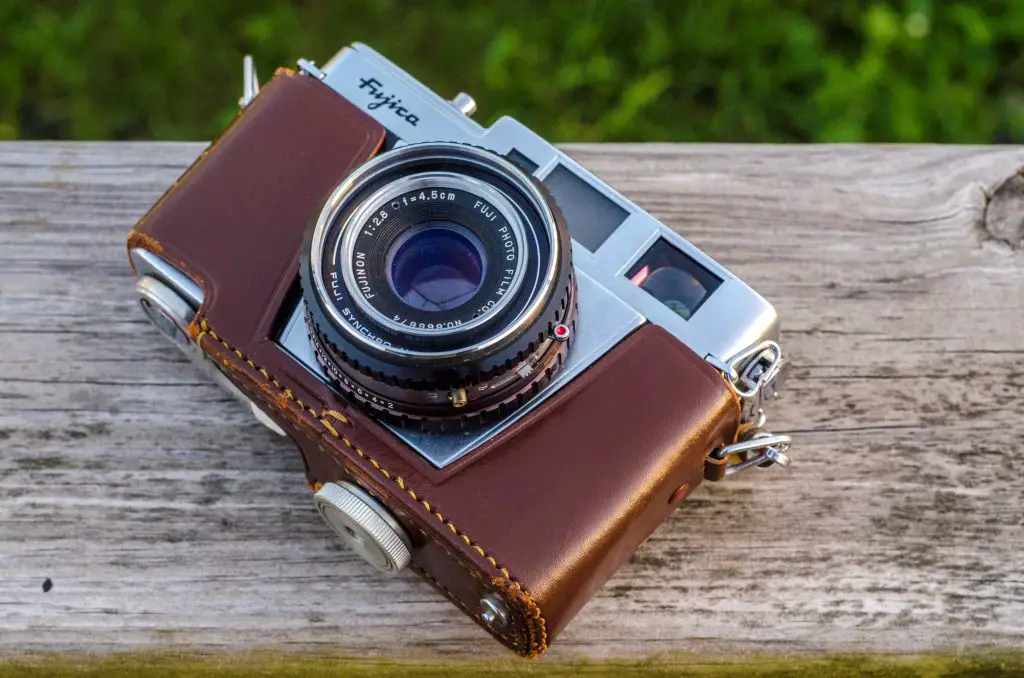 Film Type: 135 (35mm)
Film Type: 135 (35mm)
Lens: Fujinon 4.5cm f/2.8 coated 5 elements
Focus: 2.5 feet to Infinity
Type: Coupled Rangefinder
Shutter: Fuji Synchro MXL Leaf
Speeds: B, 1 – 1/500 seconds
Exposure Meter: none
Battery: none
Flash Mount: M – X PC Sync
Manual (starts on page 33): http://www.cameramanuals.org/fuji_pdf/fujica_guide-01.pdf
How these ratings work |
The Fujica 35-ML could perhaps be my surprise of the year. It came to me as just another Japanese rangefinder. The more I used it, I not only appreciated it’s quirks, but I embraced them. The camera was easy and fun to use. It’s lightweight and compact, and looks great. When I saw the images it made, I was blown away at the quality. Fuji’s 5-element f/2.8 lens outshoots it’s specs by a wide margin. This is a really well built camera that I honestly can’t come up with any complaints about. I cannot recommend this camera enough and absolutely cannot wait to shoot with it again! | ||||||
| Images | Handling | Features | Viewfinder | Feel & Beauty | History | Age | |
| 2 | 2 | 1 | 2 | 2 | 0 | 30% | |
| Bonus | +1 for the complete package, excellent lens, and ahead of it’s time size and layout. | ||||||
| Final Score | 12.7 | ||||||
History
In the early part of the 20th century, there was a thriving celluloid market in Japan due to the increase in popularity of the motion picture industry. Motion picture film was made out of a flammable material called celluloid. It’s use was prevalent in all types of film in the early part of the 20th century.
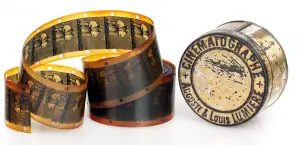
To accommodate the demand for celluloid, around 1908, at least two different companies named Sakai Celluloid Co., Ltd and Japan Celluloid Artificial Co., Ltd were created in Japan. Over the course of the next several years, more and more companies entered the market with their own celluloid production. For the first few years of the 1910s, the celluloid market thrived. Interest in film during the beginning of the first World War continued to grow and the large Japanese celluloid industry was booming.
Around 1918, after the war had ended, demand for celluloid would quickly decrease, causing the entire Japanese market to fall into turmoil. In an effort to survive, many of the leaders of the various celluloid businesses would all agree to join forces and create a single entity in the market to better survive. In September 1919, with a capital of 12.5 million yen, the Dai-Nippon Celluloid Company would be founded as a unified producer in the Japanese celluloid industry.
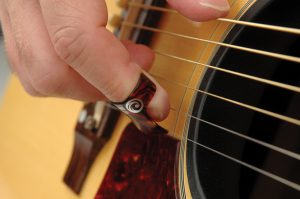
The plan worked, and in the 1920s, Dai-Nippon would become one of the world leaders in celluloid production. Although most commonly used in cinema film, celluloid had uses in other products such as jewelry, buttons, dolls, fountain pens, musical instruments, and knife handles. The company’s profits soared, and by 1934, there was a need to separate the film business from the rest of the company, so as a result the Fuji Photo Film Co., Ltd was formed in January 1934 to concentrate solely on celluloid production for the film industry.
Over the next decade, Fuji would produce all varieties of cinema and still film, along with other types like that used in X-rays and other scientific equipment. Their goal was to be the premiere Japanese film maker and compete with the likes of Kodak and AGFA.
In the early 1940s, Fuji would expand their operations and begin making optical products solely for the Japanese military. In my research for this article, I could find very little information about what types of products these were, but most likely they were lenses for scopes, binoculars, and other war-time products.
After the war, it seems that the Fuji company would reorganize into several smaller divisions, all managed under the same corporate umbrella, but what little I could find on it was hard to follow. As best as I can tell, these separate Fuji companies would all fall into a single entity known as the Fujifilm Group.
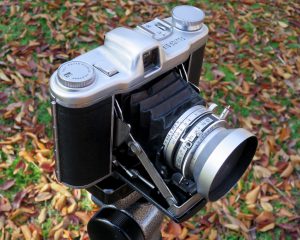
In 1948, Fuji would release it’s first camera, a medium format folding camera called the Fujica Six which would shoot 6cm x 6cm images on 120 roll film. Fuji likely followed the trend of combining it’s own name with ‘camera’ to come up with Fujica, just like Leica, Konica, and Nicca had done.
The Fujica Six would most closely resemble other German 6×6 medium format folding cameras like the Zeiss-Ikon Nettar and the Nagel Vollenda. It was a pretty successful model, spawning several variants and staying in production until at least 1953.
During the 1950s, Fuji would experiment with several other film cameras like the Super Fujica Six, and the Fujicaflex TLR, but their focus was still on photographic film.
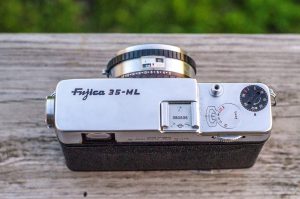
In 1957, Fuji would release an all new solid bodied 35mm camera called the Fujica 35 M. This camera was a completely new design and looked unlike any other Japanese made camera at the time. It was a handsome camera with several unique design features. Most prominent was the rear thumb wheel focus system. Instead of a traditional collar around the lens, the focus of the camera was changed by the photographer’s right thumb on the back plate of the camera just like on the Voigtländer Vitessa. Fuji’s advertisements of the era championed this feature as being faster than the traditional collar method.

Other unique design features were a film rewind knob that was located on the side of the camera, rather than the top. By placing this knob on the side of the camera, Fuji was able to shorten the width of the camera since there didn’t need to be space for an entire wheel. Finally, the last unique design element (at least unique compared to other Japanese cameras) was the bottom wind lever. This lever looked and functioned nearly identical to other bottom wind cameras like the Kodak Retina of the late 1950s.
The Fujica 35-M series would spawn a couple of variants, like the ML being reviewed here. Originally featuring 5-element f/2.8 lenses and Fuji designed leaf shutters, later models would be upgraded to f/2 and f/1.8 lenses with Citizen and Seiko shutters. Later models would add selenium cell and eventually CdS meters.
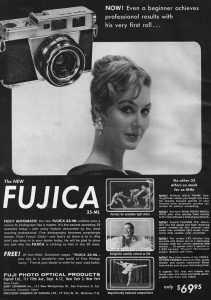
I didn’t find a whole lot of info about this camera while researching this article but the ad to the right from 1959 suggests the retail price was $69.95. When adjusted for inflation, that is like $581 today. Certainly not unobtainable, but also not something just the average person would buy.
While Fuji had undeniable success in the film industry, it seems as though their camera business was a bit of an afterthought. Fujica SLRs of the 70s and 80s seemed to have limited success, but what little I could find about cameras like the 35-ML seem to be few and far between. Everything I’ve read seems to be positive, but I find it strange that a successful company like Fuji did not achieve greater success making cameras back then.
Today, these cameras rarely go for much on the used market, which is a shame because the 35-ML is an excellent camera. Sure, it has some strange design quirks, but they make for an interesting shooting experience. Optically, the Fujinon lens is quite good. The 5-element lens was a step up from other 3 and 4 element f/2.8 lenses of the era.
My Thoughts / Repairs
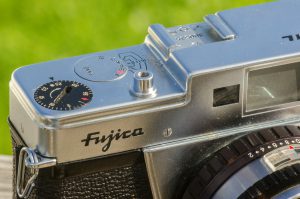
Fuji’s history as a maker of film is so well regarded that many people, myself included, likely forgot that they ever made cameras. The most common models are their SLRs from the 1970s which were neither high or low end. Many Fuji SLRs used the M42 screw mount, but starting in 1980, Fuji designed it’s own unique bayonet mount called the X-Mount which was only in production for 5 years before Fuji completely exited the camera making business.
Prior to these SLRs however, Fuji was like many other Japanese camera companies and they released many of their own designs trying to compete in an ever crowded market.
It was strange to me then, when one day while looking at some auctions, I saw this pretty little camera that I knew nothing about. Upon further research into the model, I realized I had discovered a small gem of a camera and while it likely produced images comparable to other rangefinders of the day, it’s unique features, compact body, and handsome design won me over.
I was elated when the camera arrived that it was in good working order. The only issue I had with it was that that there was a slight vertical alignment issue with the rangefinder and that the viewfinder windows were a little dirty. Usually these kind of repairs can easily be made by removing the top plate of the camera and adjusting a screw and wiping down the glass.
That proved to be true, mostly. Getting the top plate off the Fujica was quite easy as I only needed to remove 4 screws, one on each side of the top plate and the entire top lifted off. Beneath the top plate was mostly similar to that of other rangefinders. The glass elements were all easily cleaned with a Q-tip and some glass cleaner. Like with most rangefinders, special care must be taken to not touch the diagonal beamsplitter on the left side of the camera. This beamsplitter has a very fragile semi-reflective surface which can be easily wiped off if you are not careful. It’s best to just not touch the beamsplitter at all. Use caution when cleaning the other glass elements in here.
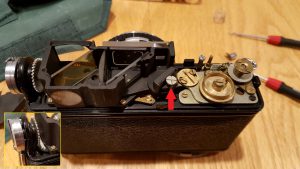
The vertical rangefinder adjustment was the large plus headed screw indicated by the red arrow in the image to the right. I took the camera outside and pointed it at a utility pole down the block, set the camera at infinity, and then turned it 90 degrees to adjust the vertical alignment on that same pole until it was as perfect as I could make it. It’s worth noting that on some cameras, adjusting the vertical alignment can also slightly change the horizontal alignment, so sometimes you need to change that too. I serviced this camera months ago, and sadly, I am not 100% sure as I write this, but I believe the horizontal adjustment is the brass screw to the left of the red arrow in the previous image.
While the top was off, I got to observe some of the uniqueness of the Fujica, specifically the rewind lever on the side of the camera. It works similarly to any other 35mm camera with a rewind lever, except there’s a 90 degree gear which you can see in the inset image in the bottom left corner of the previous image.
The focus thumb wheel is connected to the large brass wheel on the right side of the camera. As you rotate the wheel, it moves a feeler shaft that is connected to the lens and moves it fore and aft. With the camera completely assembled, it seems like there’s some complex voodoo going on inside of the camera, but once you can see “under the hood” it is actually all pretty simple.
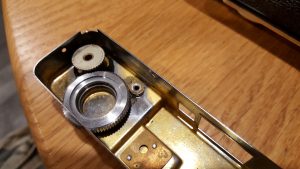
A couple of paragraphs above, I said that removing the top plate was easy to remove, mostly. The catch here is putting it back together. There are 4 contact points on the right side of the top plate for that depth of field dial, the thumb wheel, frame counter, and shutter release that all must be in the perfectly correct orientation for the camera to go back together. If something is not in it’s correct position, you’ll have problems. Further adding to the difficulty is that there is no easy way to hold everything in the correct position in the top plate while slipping it over the camera.
It took me a good 45 minutes worth of trial and error, but I finally was able to succeed by placing the top plate upside down on my table like in the image to the left, and then lowering the body of the camera onto the top plate, upside down. I can’t recall how many times it took to get it right, but there were many. I routinely talk about the need for patience when working on old cameras, and it was especially true here as my patience wore thin a number of times. Thankfully, I got it and the camera went back together smoothly without any other issues.
Feeling pretty confident that the camera was in good shape, I gave the body and lens elements a quick wipe down, and I loaded in some Fuji 200 (of course) and took it with me on a family trip to Michigan in August of 2016.
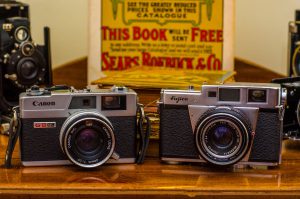
Shooting with the ML-35 was a joy. This is a compact rangefinder resembling the size and weight of 1970s rangefinders like the Canonet QL17 GIII, the Konica Auto S3, and the Olympus 35DC, but it wasn’t made in the 1970s. It was made in the 50s. According to my kitchen scale, the Fujica weighs 651 grams, compared to a Canonet QL17 GIII weighing 604 grams. The difference is likely due to increased use of plastic in the Canonet as the two cameras are very similar in every dimension.
The Fujica 35-ML has a large and bright viewfinder with an easy to use coincident image rangefinder. There are gold foil bright lines with parallax correction for the exposed image. The parallax correction is a welcome feature for a camera like this with a close focus of 2.5 feet. As a person who wears prescription glasses, I had no issue framing my shots using the large viewfinder. In fact, page 36 of the Fujica manual states that glasses wearers will bless the large rear window opening.

Although it lacks a meter of any kind, it does have a coupled light value system on the lens barrel. I used to really hate cameras with these integrated LVS systems because the first models I encountered with them were limited and added complexity when changing both aperture and shutter speed. I chided the systems on the Flexaret VII and the Retina IIc as they seemed to get in the way more than they helped. Then I discovered the Yashica Minister-D whose LVS system still linked both aperture and shutter speed together, but it was easy to override when your lighting changed. I finally saw the light. I didn’t hate LVS systems, I just hated the previous implementations of them.
The Fujica and the Yashica Minister-D work by setting a light value that corresponds to your scene. In the previous image, these are the bottom row of numbers from 2 – 18. If you want to increase or decrease exposure, you adjust either the aperture or shutter speed to whatever value you want. It’s really that simple. The camera doesn’t fight you like the system on the Flexaret, and it’s not out of the way requiring you to lower the camera and look at the bottom of the lens like on the Retina.

The thumb wheel focus, while neither better or worse than traditional lens barrel mounted systems, did allow for a shorter lens depth, and therefore smaller camera since there is no need to extend the length of the lens to include a standard collar. The side mounted rewind knob also adds to the slimness to the camera. While I can’t say Fuji reinvented any wheels, they absolutely did an outstanding job of thinking outside the box when designing the Fujica to make it as compact and lightweight as possible. It’s design was ahead of everyone else by nearly a decade and a half.
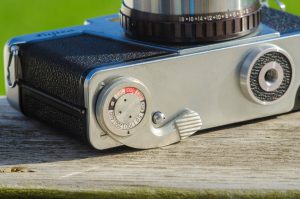
As I went through that first roll, the more confidence I gained with the camera. I absolutely loved using it. The rangefinder patch was bright and easy to see. I felt so comfortable during that first roll, that I ventured inside and shot a few interior shots, something I don’t often do the very first time using a new camera.
Of course, all the joy I had while shooting could be for naught, if the images it made weren’t any good. So were they?
My Results
I take my time when writing reviews for this site. In some cases, I start reviews months in advance of publishing it. There could be various reasons for that, sometimes it takes me a while to find the right time to shoot a camera, sometimes they are in need of repair and I just dont have the time, and sometimes, even after shooting the camera, it takes me a while to get the film developed. I shot this Fujica in August and it’s now November 17th as I type this.
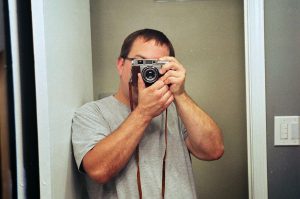
Earlier today, I finished the review for the Yashica Lynx-14, a large rangefinder camera with a fast 7-element f/1.4 lens that was designed for low light photography. The Lynx-14 regularly sells on eBay for quite a bit of money when in working condition because of the popularity of that lens. This Fujica however, almost always goes unnoticed. I didn’t even know it existed until I saw this one for sale. You rarely hear anyone talk about them, and on paper, the camera’s compact size and common f/2.8 lens doesn’t suggest anything particularly special.
Yet, doing these two reviews back to back, I find that the two cameras were polar opposites. Where the Lynx should have excelled in many ways, it disappointed me. The Fujica only got better as I used it. The Fujica is a svelte and compact camera that is easy to hold and fits nicely in your pocket, whereas the Lynx is a huge hulking metal beast. I found the Fujica’s viewfinder large and easy to use. The Lynx’s was partially obscured by the large lens and a blacked out section for the match needle exposure system. The Fujica’s rangefinder patch was easy to see, and focusing was not a chore, even indoors. I couldn’t say the same for the Lynx. As for image quality, that Lynx had an issue with it’s lens that I cannot fault the camera for, but even if it was working correctly, I would have expected the images to look nice and sharp, simply due to the reputation of it’s lens. I would have expected the Fujica’s modest lens to have some flaws.
Bright sun, full shade, high contrast, indoors, outdoors, it didn’t seem to matter what I threw at the Fujica, it excelled every time. The above gallery only represents 8 of the 24 images from that roll, but all 24 were sharply in focus with nearly perfect exposure. If I had one criticism of these images, it’s that they exposed the limitations of Fuji 200 film. I can see some visible grain in the images and the extreme contrast in some images stretched the latitude capability of Fuji 200. I am curious to see what other films like Ektar, or Tri-X would look like using this camera.
When I think of all the reasons why one classic film camera is more or less appealing than others, there is never just one reason. I think that in order to have a favorite camera, there has to be a combination of excellent results, a handsome design, fun to use, and some kind of unique or quirky characteristic, and the Fujica 35-ML has all of that. I am not saying this is the best camera ever made as I am sure there are arguments for many other models, but I will say that when it comes to what I like about using these old devices, this camera is very near the top of my list.
To think that I wasn’t even aware of this model prior to spotting it for sale on eBay, makes it even more of a pleasant surprise and I really hope that anyone reading this review has a chance to try out one of these wonderful models. You may not have the same level of appreciation as I have, but I would be absolutely shocked if it didn’t at least put a smile on your face!
Additional Resources
http://www.asahi-net.or.jp/~rd2h-ari/FUJICA_LIST2.htm
http://photo.net/classic-cameras-forum/00XycF
http://www.nishigawakobo.com/technical-details/?lang=ja
http://www.collection-appareils.fr/x/html/camera-1457-Fuji_Fujica%2035-ML.html

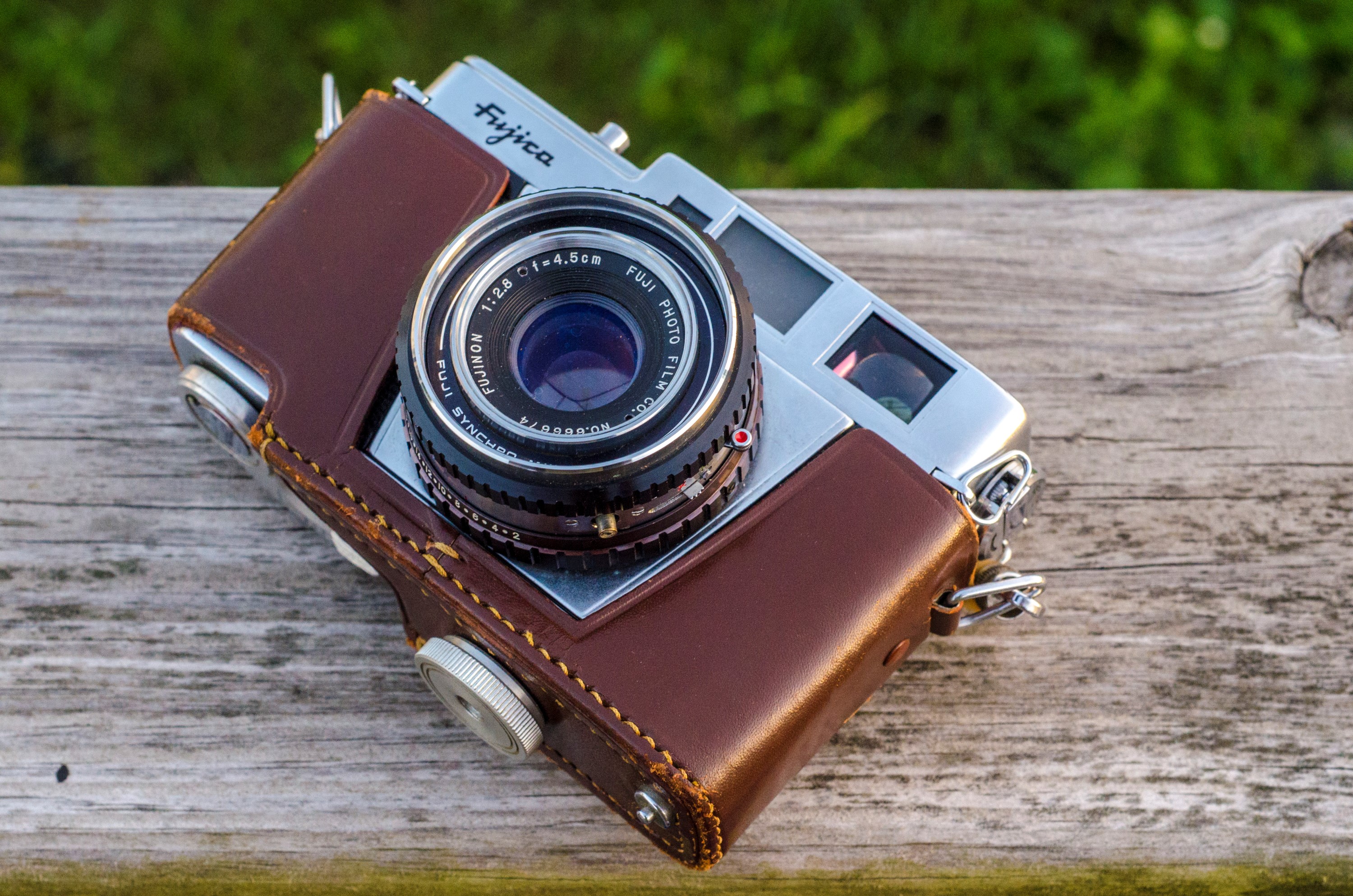
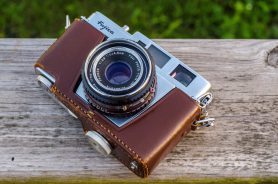








Hi!
Really complete and interesting review.
Back in October, I’ve looked for resources on how to adjust the rangefinder on a F2 version of this camera. Too bad you did not publish in time! 🙂 However, I was able to discover that the accessory shoe hides 2 holes giving access to the setting screws.
I can also confirm that the brass screw sets the horizontal alignment.
See the details on photo.net: http://photo.net/classic-cameras-forum/00eBY3
I’ve yet to try the camera, but your results are really encouraging.
A couple of questions:
– Have you encountered issues when testing slow speeds? While my camera’s faster speeds “sound” OK, the 1sec and B speeds both specifically & occasionally miss and shoot at instant speed. This seems to happen no matter the Exposure Value selected.
– More advice than question: do you use a light meter mounted on the accessory shoe? Do you have any model to recommend?
That was a pleasant reading, thanks for your time writing these nice reviews.
Have a nice day.
Laurent
Laurent, thank you for the kind words, and I am glad I was able to at least partially give you some useful information.
These reviews often take me many months to complete and unfortunately, sometimes I do the repairs long before I write anything down, and in the case of this Fujica, my repairs weren’t as fresh in my mind as they are for other cameras, so I couldn’t include as detailed of information as I usually try to. Thanks for the link as I am sure someone else will eventually stumble into here and perhaps it can benefit them! 🙂
For your two questions, my shutter speeds all worked perfectly on this example. I didn’t have to do anything to get them to work thankfully. For your issue, the slow speeds acting like instant is a very common problem on Compur shutters which have the slow speed governor gummed up. While the Fujica does not have a Compur shutter, it is plausible that the Fuji shutter took similar design cues from it.
If you are willing to partially tear down the shutter, you can likely resolve this issue by soaking the shutter in naphtha oil or something similar. Usually all these old cameras need is something to dissolve the old crusty lubrication that slows them down. If you try this, make sure you allow sufficient time for the fluid to completely dry before attempting to use the camera.
As for a light meter, no, I do not use any accessory light meters I do own a couple of them and have tried them on occasion, but I’ve gotten pretty good at estimating exposure using Sunny 16. When I am in doubt, I use a light meter app on my phone. It’s not as accurate as the real deal, but it always gets me close enough!
Good luck to you and enjoy your Fujica, they are really wonderful cameras!
Hi Mikw, it is very interesting, I bought a Fujica 35 SE yeterday and did a CLA then I found your information. I followed your Yahsica review then this Fujica. I like both camera I am shooting a roll on Lynx-14 but not finished yet. I shall shoot this as well. Your picture of this Fujica give me a shocking as the image are stunning and better then the Lynx-14. Thanks for your information. John
On my camera, a 35-ml, when overriding the ev with 400 asa film with a shutter speed of 500
I can only close the lens to f8 corresponding to an ev of 18
which is the upper value on the scale
The sunny 16 rule can only be applied with asa 100 or lower film.
Is this a design restriction or a mechanica fault on my camera
Or am I missing something
Peter Marler
I was missing something
When I checked shutter and aperture settings on the camera against its ev vale and against an exposure meter I found that the camera has a consistent over value of 3 ev values on the camera
eg
meter ( and sunny 16 gives 100 asa 125 sec f11 ev 14
camera gives 100 asa 125 sec f11 ev reads 17, 3 ev values to high
So at some time a service has assembled the mechanical linklink incorrectly. My local man will correct this
Peter Marler
There is a version with a f/1.9 lens.
And how to service the stuck shutter?
Thanks
Dom
Ive got a fujica 35-ml. The shutter doesnt work. Anybody likes to get my cam?
I’m really pleased I found your post on the Fujica 35-ML. I was born in 1957 and was given my first camera (an Agfa Rapid) at the age of 6 or 7. However my dad had a Fujica 35-M or -ML and I was very envious! It always produced excellent results and was eventually passed on to me when I reached the age of 13 or 14. After a couple of years I bought a Zenit B but regretted giving up the Fujica. Even now looking back at my colour transparencies from the period, those taken with the Fujica are the best quality.
The camera was exactly as in your photos, complete with the yellow stitched tan leather case. I remember feeling that the images it produced were sharper and richer in colour than those I produced with other 35mm film cameras I owned later. Eventually I became a big OM fan and now own a variety of camera of various makes. However if I ever found a Fujica 35-M or -ML for sale at a sensible price, I’d buy it without hesitation!